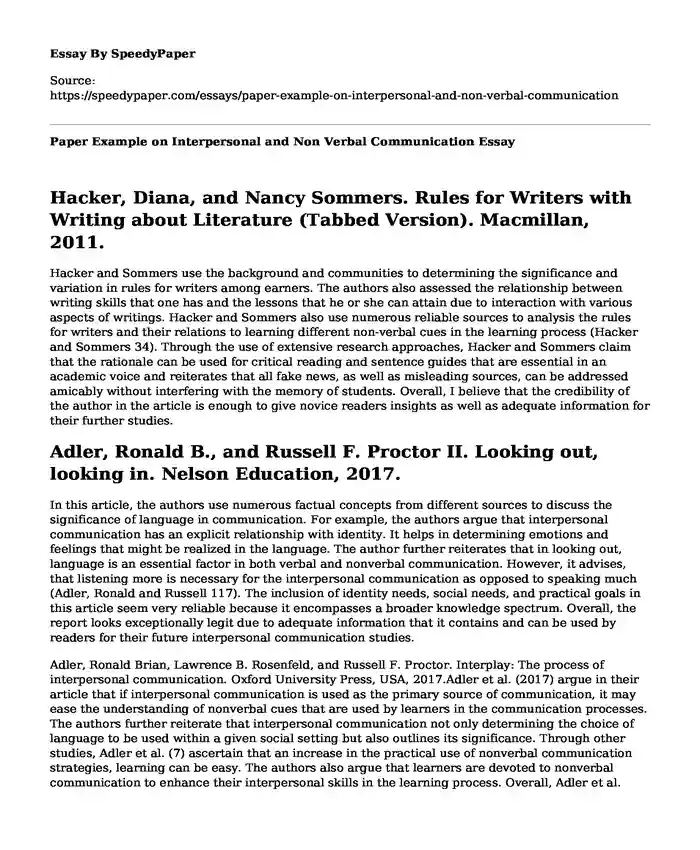
| Type of paper: | Annotated bibliography |
| Categories: | Communication Interpersonal communication |
| Pages: | 3 |
| Wordcount: | 623 words |
Hacker, Diana, and Nancy Sommers. Rules for Writers with Writing about Literature (Tabbed Version). Macmillan, 2011.
Hacker and Sommers use the background and communities to determining the significance and variation in rules for writers among earners. The authors also assessed the relationship between writing skills that one has and the lessons that he or she can attain due to interaction with various aspects of writings. Hacker and Sommers also use numerous reliable sources to analysis the rules for writers and their relations to learning different non-verbal cues in the learning process (Hacker and Sommers 34). Through the use of extensive research approaches, Hacker and Sommers claim that the rationale can be used for critical reading and sentence guides that are essential in an academic voice and reiterates that all fake news, as well as misleading sources, can be addressed amicably without interfering with the memory of students. Overall, I believe that the credibility of the author in the article is enough to give novice readers insights as well as adequate information for their further studies.
Adler, Ronald B., and Russell F. Proctor II. Looking out, looking in. Nelson Education, 2017.
In this article, the authors use numerous factual concepts from different sources to discuss the significance of language in communication. For example, the authors argue that interpersonal communication has an explicit relationship with identity. It helps in determining emotions and feelings that might be realized in the language. The author further reiterates that in looking out, language is an essential factor in both verbal and nonverbal communication. However, it advises, that listening more is necessary for the interpersonal communication as opposed to speaking much (Adler, Ronald and Russell 117). The inclusion of identity needs, social needs, and practical goals in this article seem very reliable because it encompasses a broader knowledge spectrum. Overall, the report looks exceptionally legit due to adequate information that it contains and can be used by readers for their future interpersonal communication studies.
Adler, Ronald Brian, Lawrence B. Rosenfeld, and Russell F. Proctor. Interplay: The process of interpersonal communication. Oxford University Press, USA, 2017.Adler et al. (2017) argue in their article that if interpersonal communication is used as the primary source of communication, it may ease the understanding of nonverbal cues that are used by learners in the communication processes. The authors further reiterate that interpersonal communication not only determining the choice of language to be used within a given social setting but also outlines its significance. Through other studies, Adler et al. (7) ascertain that an increase in the practical use of nonverbal communication strategies, learning can be easy. The authors also argue that learners are devoted to nonverbal communication to enhance their interpersonal skills in the learning process. Overall, Adler et al. have credible information that is essential for novice readers to develop outstanding insight into the relationship between interpersonal skills and nonverbal communication.
DeVito, Joseph A., and Joe DeVito. "The interpersonal communication book." (2015).
The authors of this article begin by outlining preliminaries that are essential to interpersonal communication and their benefits to learners. DeVito, Joseph, and Joe DeVito argue that understanding interpersonal skills and the ethics that are available in it plays a vital role in ensuring communication processes regardless of the method adopted. Interpersonal communication creates a rationale that can bind both the learners and their teachers for common goals. The article further states that through the use of a threefold approach, important communicative concepts can be identified and used in various situations (DeVito, Joseph and Joe DeVito 21). The article also allows students to adequately examine the question when, how, and through which method of communication a given utterance has been passed. Overall, this article equips readers with expansive knowledge about the importance of interpersonal skills for the success of communication.
Cite this page
Paper Example on Interpersonal and Non Verbal Communication. (2022, Dec 26). Retrieved from https://speedypaper.net/essays/paper-example-on-interpersonal-and-non-verbal-communication
Request Removal
If you are the original author of this essay and no longer wish to have it published on the SpeedyPaper website, please click below to request its removal:
- Free Essay with Chemistry Problem Solving
- Globalization Definition Essay Example
- Essay Sample on the Advancement in Information Technology
- Qualities of a Great Coach
- Essay Sample about Mexican Americans Between 1940s and 1970s
- Free Paper Sample: Nissan Company and Green Information Technology
- Essay Sample on Higher Education in America
Popular categories




